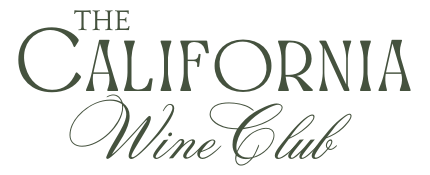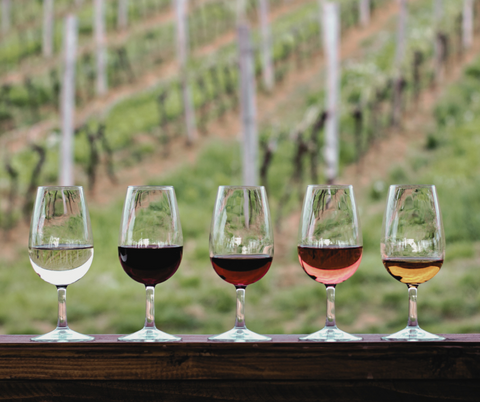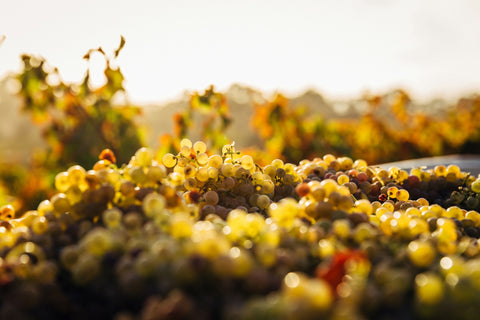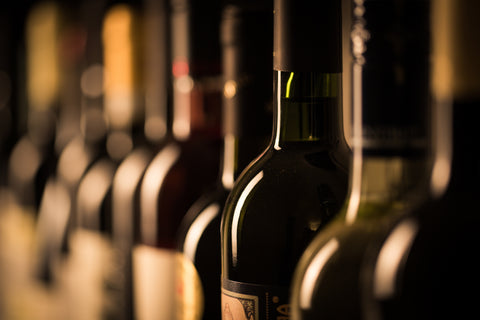How much do you really know about wine? Test your wine knowledge with these 25 facts about 5 of the most popular wine varietals: Cabernet, Pinot, Zin, Chardonnay, and Sauvignon Blanc. Plus, learn a little more about the hard to pronounce but delicious nonetheless Viognier varietal.
Experts can devote decades to studying wine and its history, its mysteries , and all the amazing aromas and flavors that come from winemaking. And although the only thing you ever really need to know about wine is whther you love what’s in your glass, we think a bit of knowledge can add pleasure to the pour.
Cabernet Sauvignon
- It has an interesting family. It is originally from France and its parents are Sauvignon Blanc (really) and Cabernet Franc. Its half-sibling is Merlot – they both have Cab Franc as a “father” but different “mothers.” In blind tastings, it can sometimes be hard to distinguish Cabernet Sauvignon from Merlot, even for pros.
- It is really, really popular. It is one of the most widely planted wine grapes in the world, possibly the most planted. The number of plantings world-wide DOUBLED between 1990 and 2010. And it is the most planted vine in the fastest growing wine producing country: China. However, in its home, Bordeaux, Merlot is the more popular planting. Part of the reason for Cabernet’s popularity in the vineyards is that it’s hardy and fairly easy to grow.
- The most prized red blends in the world include Cabernet. Bordeaux-style blends (also known as Claret in Britain) can include any combination of Cabernet Sauvignon, Merlot, Cabernet Franc, Malbec and Petite Verdot. Cabernet Sauvignon provides the backbone and structure for these highly sought after wines.
- It ages gracefully. It is one of the most tannic of all the major reds and its phenolics (chemical compounds) allow it to age well. Part of the reason it is so tannic is that it has thick skin and the berries are small. Smaller berries mean more pips and less pulp per berry. Tip: Young, highly tannic Cabs pair beautifully with well-marbled steaks, but aged Cabs (8 to 12 years) have mellower tannins and can pair with a much broader range of foods (including chicken). Learn why aged Cabernet is hard to find.
- It can take the heat. It is late-ripening, and needs a warmer climate to fully mature. In cooler regions, it often exhibits green bell pepper and eucalyptus flavors, which are not considered “wine faults” and are preferred by some wine lovers.
– Karen MacNeil, The Wine Bible.
Pinot Noir
- It’s old & French. OK, you probably knew the French part. To get specific, this light, dry red hails from the Burgundy region of France, where it is the primary red wine. But did you know it is thought to be about 2,000 years old? Compare this to Cabernet Sauvignon, which is thought to be a few hundred years old. Due to its long history, Pinot Noir is considered the grandparent or great grandparent to many grapes, including Syrah.
- It’s transparent. It can’t hide anything–it clearly shows terroir and is easily influenced. This is why it is not usually blended with any other varietals and it is often vineyard-designate (produced from a single vineyard). “Even small differences in the grape show through in the final wine. This means that all of the various characteristics of and decisions in the vineyard will deliver a very different wine from site to site. Sun exposure, temperatures, soil types, crop yield, etc. can differ literally from one side of a road to another,” explains Fulcrum founder/winemaker David Rossi. Plus, it is often actually see-through in the glass. But make no mistake: it is NOT a lightweight in nose or taste.
- It’s difficult. It is hard to grow and hard to make into wine. Small climate changes greatly change this delicate grape, it is prone to various wine diseases, and it oxidizes easily in the winemaking process. It is a much riskier wine for both growers and winemakers than other popular reds. That’s one of the reasons it is highly sought after (and can be expensive). Andre Tchelistcheff, one of America’s most influential winemakers declared that “God made Cabernet Sauvignon whereas the devil made Pinot Noir.”
- It makes great Rosé. To make Rosé in the traditional Provence style, you pick grapes when they are much less ripe. The lower sugars mean lower alcohol and greater acidity, so the Rosé is crisp and refreshing. With Pinot Noir (and Grenache) grapes, you don’t get “green” flavors when you pick early.
- It’s friendly. With its lighter body, it is often the first red that white wine lovers enjoy, and it is one of the food-friendliest reds. It has the kind of acidity that is so important to versatility with food. The more fruit-forward the Pinot is, the better is with fattier fare, like roast chicken, lasagna, salmon or halibut. Bigger Pinots can stand up to game meats and birds, as well as beef. These types of Pinot often come from California, due to the weather. Oregon generally produces leaner Pinot Noir which in our opinion is even more able to pair well with many kinds of food, including Chinese, Indian, lamb, pizza … the list goes on. In fact, the only food we would not choose for Pinot is anything too hotly spicy.
If you’re already a member of our wine club, you can browse all the Pinot Noir we have available for sale on our site and order your favorites here. Not yet a member? Learn more about our monthly wine clubs.
Zinfandel
Whether fruity and jammy or spicy and elegant, Zinfandel is a hearty red with a wonderful pour. It’s a perfect match with pepperoni pizza or spicy curry dishes, as well as with fine cuts of beef. It can even be used to spice up cranberry sauce. Here are six things to know about Zinfandel.
1. The mystery around it has been solved. Despite various theories over the decades, DNA evidence now tells us it hails from Croatia.
2. It is considered California’s heritage grape. Believed to have been first planted in California in the 1850s, there are vines well over 100 years old in Amador country and Sonoma. There is no legal definition of “old vine,” but 40+ year old vines are typically considered old by winemakers.
3. It ages gracefully. When well-made, it has the structure to improve in age like a Cabernet.
4. It has wings! Well, it has a “wing” which is like a second, smaller bunch growing off to one side.
5. White Zin saved it. In 1972, Sutter Home famously created their extremely popular White Zinfandel. While some wine lovers consider this an “entry level” wine, we have this pink pleaser to thank for today’s wonderful old-vine Zins. Its popularity ensured that Zinfandel vines were not grafted over when red Zin fell out of favor in the late 70s.
6. People LOVE it. It has an official promotional organization, ZAP, and its own event. Until Cabernet Sauvignon passed it in 90s, it was the most widely planted red grape in California. The most popular wine we have ever featured is Gnekow Family Campus Oaks Old Vine Zin.
Chardonnay
- It has French twins: French Chablis and White Burgundy are both made from Chardonnay grapes. The Chablis region is Northern Burgundy, next to the Champagne region, and this cool-climate produces a crisp, steely wine. White Burgundy comes from more southern parts of the region, and the extra warmth means fruitier flavors.
- It loves to sparkle: Chardonnay is a major component in many Champagnes and sparkling wines. It is often the only grape used in Blanc de Blancs.
- It’s a chameleon: Crisp and lean, tropical and fruity, toasty and oaky–Chardonnay can be made in many different styles. Malolactic fermentation can give it a buttery, creamy texture. In a cooler climate it produces a more mineral-ly wine. Aging in oak, stainless steel or a mixture of the two greatly changes what is in your glass.
- It is easy to pair: Buttery Chardonnay pairs with buttery foods, like succulent lobster with melted butter. Oaky Chardonnays go with smoky grilled foods. Crisp and lean Chardonnay goes well with a lot things, including seafood or roast chicken and veggies.
- It has haters: In some circles, “ABC” stands for “Anything But Chardonnay.” This was in response California Chardonnay for a time becoming a uniform mixture of butter and oak, based on the success of Kendall Jackson’s version. You can now easily find California Chardonnay made in a wide variety of styles.
Sauvignon Blanc
- It’s very easy to match to food. Just remember that it pairs beautifully with anything you would squeeze lemon on. Cold seafood platter? Check. Grilled Halibut? Check. Roast vegetables? Check. It also is terrific with Gruyere or ripe chevre cheese and anything garlicky.
- It has a romantic past. Centuries ago, in some sunny vineyard in France, Sauvignon Blanc vines met up with Cabernet Franc. The two crossed and it was … well … magic: they created Cabernet Sauvignon.
- It has an alias. Fumé Blanc –coined in California in the 1960s and popularized by Robert Mondavi. Fumé Blanc is Sauvignon Blanc. Sometimes it is aged in oak, giving it smoky notes (fumé means smoke), but it is not required that it be aged in oak.
- It has a French best friend. In France, Sauvignon Blanc is often blended with Sémillion.
- It has a wild side. It requires a lot of hands-on vineyard work to keep this vigorous vine from growing out of control (“sauvignon” means “wild”).
Cheers to this wild white!
Viognier
We’ve been told that if this lovely white was easier to pronounce, it would overtake Chardonnay as the favorite white wine in the U.S. So how do you say it? Because it originated in the Rhône region of France, Viognier is pronounced “vee-Oh-NYAY.” This is a full-bodied, rich white with flower fragrances that are often referred to as perfume-like. Interestingly, it is one of the few white wines commonly blended with red wine, particularly with Syrah. It is not a sweet wine, but it is fruit-forward. Turkey, chicken, tuna, crab and spicy foods all pair beautifully with this flavorful white.





Comments (0)
There are no comments for this article. Be the first one to leave a message!